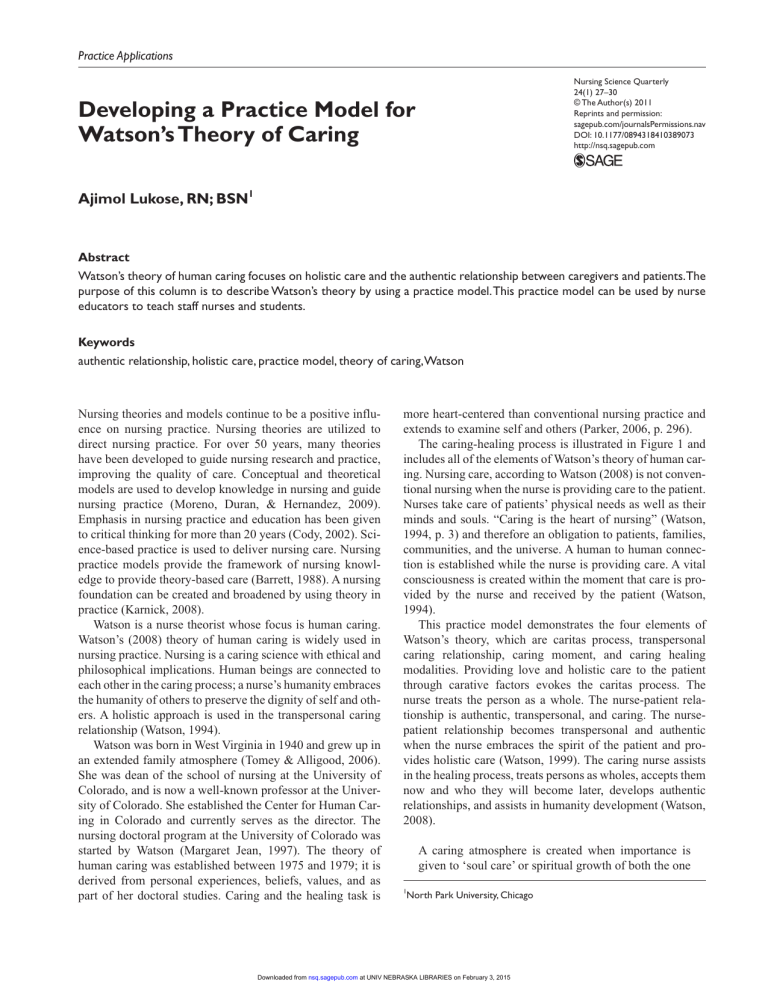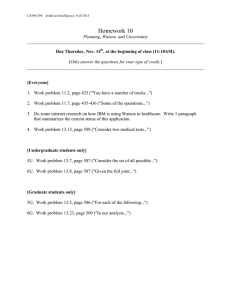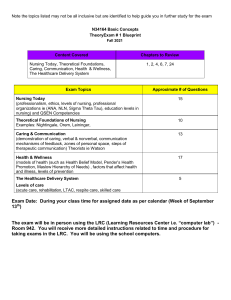
Practice Applications Nursing Science Quarterly 24(1) 27­–30 © The Author(s) 2011 Reprints and permission: sagepub.com/journalsPermissions.nav DOI: 10.1177/0894318410389073 http://nsq.sagepub.com Developing a Practice Model for Watson’s Theory of Caring Ajimol Lukose, RN; BSN1 Abstract Watson’s theory of human caring focuses on holistic care and the authentic relationship between caregivers and patients.The purpose of this column is to describe Watson’s theory by using a practice model. This practice model can be used by nurse educators to teach staff nurses and students. Keywords authentic relationship, holistic care, practice model, theory of caring, Watson Nursing theories and models continue to be a positive influence on nursing practice. Nursing theories are utilized to direct nursing practice. For over 50 years, many theories have been developed to guide nursing research and practice, improving the quality of care. Conceptual and theoretical models are used to develop knowledge in nursing and guide nursing practice (Moreno, Duran, & Hernandez, 2009). Emphasis in nursing practice and education has been given to critical thinking for more than 20 years (Cody, 2002). Science-based practice is used to deliver nursing care. Nursing practice models provide the framework of nursing knowledge to provide theory-based care (Barrett, 1988). A nursing foundation can be created and broadened by using theory in practice (Karnick, 2008). Watson is a nurse theorist whose focus is human caring. Watson’s (2008) theory of human caring is widely used in nursing practice. Nursing is a caring science with ethical and philosophical implications. Human beings are connected to each other in the caring process; a nurse’s humanity embraces the humanity of others to preserve the dignity of self and others. A holistic approach is used in the transpersonal caring relationship (Watson, 1994). Watson was born in West Virginia in 1940 and grew up in an extended family atmosphere (Tomey & Alligood, 2006). She was dean of the school of nursing at the University of Colorado, and is now a well-known professor at the University of Colorado. She established the Center for Human Caring in Colorado and currently serves as the director. The nursing doctoral program at the University of Colorado was started by Watson (Margaret Jean, 1997). The theory of human caring was established between 1975 and 1979; it is derived from personal experiences, beliefs, values, and as part of her doctoral studies. Caring and the healing task is more heart-centered than conventional nursing practice and extends to examine self and others (Parker, 2006, p. 296). The caring-healing process is illustrated in Figure 1 and includes all of the elements of Watson’s theory of human caring. Nursing care, according to Watson (2008) is not conventional nursing when the nurse is providing care to the patient. Nurses take care of patients’ physical needs as well as their minds and souls. “Caring is the heart of nursing” (Watson, 1994, p. 3) and therefore an obligation to patients, families, communities, and the universe. A human to human connection is established while the nurse is providing care. A vital consciousness is created within the moment that care is provided by the nurse and received by the patient (Watson, 1994). This practice model demonstrates the four elements of Watson’s theory, which are caritas process, transpersonal caring relationship, caring moment, and caring healing modalities. Providing love and holistic care to the patient through carative factors evokes the caritas process. The nurse treats the person as a whole. The nurse-patient relationship is authentic, transpersonal, and caring. The nursepatient relationship becomes transpersonal and authentic when the nurse embraces the spirit of the patient and provides holistic care (Watson, 1999). The caring nurse assists in the healing process, treats persons as wholes, accepts them now and who they will become later, develops authentic relationships, and assists in humanity development (Watson, 2008). A caring atmosphere is created when importance is given to ‘soul care’ or spiritual growth of both the one 1 North Park University, Chicago Downloaded from nsq.sagepub.com at UNIV NEBRASKA LIBRARIES on February 3, 2015 28 Nursing Science Quarterly 24(1) Figure 1. Watson’s theory of human caring—a practice model giving care and the one receiving care. A sacred space is developed when there is a connection between the deeper or higher self and people. (Watson, 1999, p. 103) Love and care collectively bring intense transpersonal caring and generates the entrance for inner healing for self and others. “Love is the maximum of consciousness and the largest resource of healing” (Watson, 2008, p. 40). This practice model illustrates the healing environment that is created when the nurse and patient experience forgiveness, compassion, and love. A sacred space is enhanced when the nurse provides holistic care and a healing environment is fostered. The caring-healing process is connected with the higher energy of the universe when soul or spirit care is provided. Dignity and harmony are preserved during the caring-healing process. The background in the square is green in Figure 1 and it represents calmness and healing. The circle is blue and represents the universe, and the curved arrow marks at the edge represent radiating energy. The arrows pointing toward the patient and the nurse in Figure 1 illustrate the nurse-patient relationship. In a caring moment, both the nurse and the patient enter into the experience of one another. The patient and nurse are in the “process of being and becoming” (Watson, 1999, p. 109). Watson is an advocate of caring, and compassion. According to Watson (2008), caring with healing is a holy process; the one who is caring and the one who is cared for benefit from the caring and healing process. Watson (2008) described nursing action as alive, evident, holding up the light, and the symbolic representation of the spirit. She explained the interconnection of a nurse and patient; the nurse is reaching to the soul of the patient, and the healing process is connected to the high energy of the universe (Watson, 1999). Watson exemplified the science of human caring, providing care through carative factors, caritas process, and authentic relationships between nurses and patients. According to Watson spiritual care is as important as physical needs. Nurses must identify caring moments with their patients. Watson believes that love, compassion, and forgiveness from patients and nurses are very important in the caring and healing process (Watson, 2008). A nurse provides love and care to a patient using carative factors that advance to the caritas process. The nurse approaches the patient holistically. Routine tasks and conventional care become holistic when utilizing carative Downloaded from nsq.sagepub.com at UNIV NEBRASKA LIBRARIES on February 3, 2015 29 Lukose factors. The nurse needs to be well prepared to provide holistic patient care and to get connected to a deeper level of humanity and the universe. When the nurse attains the deep connection, caring goes beyond doing conventional tasks. A nurse may practice centering exercises and deep breathing exercises as part of self-preparation before providing patient care. Meditative practices of compassion, kindness, and love toward self and others are part of caritas nursing (Watson, 2008). Watson (2008) developed 10 carative factors in 1979 that progress to the caritas process to guide nursing. This caritas process is the first element of Watson’s theory. Caritas originates from the Greek word meaning to cherish and give special loving attention. Caritas nursing encourages nurses to practice through the caring and healing process. Nurses not only focus on the material form, but also focus on things of spirit when practicing caritas nursing. The nurse and patient engage in authentic relationships in caring-healing practice. There is a higher-deeper level of relationship that occurs between nurse and patient during caring-healing practice. Some of the words used to cultivate spirit and soul by Watson are “beauty, silence, nature, arts, music sounds, relationship, prayer, meditation, miracles, universal love, mystery and God” (Watson, 2008, p. 199). The transpersonal caring relationship is the second element of Watson’s theory. The nurse and patient reach out to each other. “Transpersonal caring seeks to connect with and embrace the spirit of soul of the other through the process of caring and healing and being in authentic relation, in the moment” (Parker, 2006, p. 299). A caring moment is the third element of Watson’s theory. The patient and nurse come together in such a way that an occasion for human caring is created. “An actual caring occasion or transpersonal caring moment involves action and choice by both the onecaring and the one-being cared for”(Watson, 1999, p.116). The fourth element is the caring healing modalities. The nurse is able to go into a deeper level of skilled and divine practices and the nurse and patient are connected to the high energy of the universe. The healing process is enclosed in a single caring moment. The caring-healing process is interconnected and goes beyond the caring moment (Parker, 2006). “Transpersonal caring seeks deeper sources of inner healing, defined more in spiritual terms than disease elimination”(Watson, 1999, p.118). For Watson the interaction between the patient and nurse occurs both ways. Conventional nursing becomes intentional and professional when the nurse practices the caritas process and the relationship becomes authentic. Both the patient and nurse undergo a healing process (J. Watson, personal communication, March 4, 2010). Watson mentioned in an interview with Mariano (2005) that the caring-healing model needs to be considered seriously and the important elements are holism, consciousness, and intentionality. Watson also said that when she is with nurses she feels like she is reaching them at their heart level and is experiencing a glorious feeling (Mariano, 2005). Watson talked about the necessity of the spiritual growth of nurses in an interview with Henderson (1993). Watson also said, “caring is a human-to-human relationship.” Nurses have a moral and ethical responsibility to be aware of their actions (Henderson, 2003). In another interview, Watson mentioned that “caring-healing modalities and nursing arts are reintegrated as essentials to ensure attention to quality of life, inner healing experiences, subjective meaning and caring practices, which affect patient outcomes and system success alike” (Clarke, 2009, p. 341). Watson’s theory of caring has been compared with Parse’s theory of humanbecoming. Watson’s and Parse’s theories can guide the professional practice of nursing (Walker, 1996). Nurse faculty can demonstrate compassion and caring to their students as examples. Learning Watson’s theory of human caring encourages nursing students to practice human caring. This author in her job situation encourages staff nurses to practice Watson’s theory in their workplace. When staff members are engaged in any element of Watson’s theory, this author offers them a ticket which says “caught you in the act of Watson’s caring moment.” Another way the author promotes practicing Watson’s theory is encouraging performing a nursing huddle for few minutes before beginning the shift. The purpose of this nursing huddle is to identify the humanity needs of patients, spiritual needs, special ways to reach to their inner consciousness, and wish them good healing. Then at the end of the shift there should be another nursing huddle for a few minutes for reflection. This may help to improve quality of patient care, patient satisfaction, and nurse satisfaction. Noise reduction, lighting control, a clean room with adequate air exchange, art work in the patient’s room, and light music are some of the healing interventions a nurse can practice daily. Nurses may also participate in self-care by obtaining adequate sleep, rest, and personal hygiene. Beyond the task-oriented conventional care, the nurse looks for meanings of patient’s behavior, is there for the patient, and treats the patient as a whole. During a staffing shortage or working with high acuity patients, nurses can practice centering exercises and breathing exercises. Basic emotions such as love, compassion, and kindness feed the human spirit (Watson, 2008). Through the theory of human caring, Watson promoted preserving dignity and harmony and a healing environment. Practicing de-escalation techniques, restraint reduction initiatives, and fall prevention initiatives, are some other examples of promoting the theory. Sitting down with patients, holding their hand for a few minutes, maintaining eye contact, and providing reassurance are yet more examples of practicing Watson’s theory. This author believes that healthcare institutions can arrange a companion program for patients whose families may be unable to visit or for patients who do not have families. The advantage of this practice Downloaded from nsq.sagepub.com at UNIV NEBRASKA LIBRARIES on February 3, 2015 30 Nursing Science Quarterly 24(1) model is that it is not just restricted to nursing field. It can extend to other areas where love, care, and spirituality are involved. This model may be useful for parenting classes and marriage preparation classes or other life lessons. At times, theories are not practiced in conventional nursing settings due to their perceived complexity. It is the duty of advanced practice nurses to describe theory in simple language and transform it for nursing practice. (Nelson-Marten, Hecomovich, & Pangle, 1998). Financial demands, daily routines, and increased technology in nursing care may cause a negative effect in human to human caring practices (Watson & Foster, 2003). It is very important that bedside nurses understand caring theory in depth in order to apply it in daily practice. Tasks performed by the nurses become routine if they are performed without compassion. Nurses and patients need to be connected in such a way that caring and loving relationships occur between them to enhance healing. Watson’s theory is an excellent theoretical framework that can be applied in different settings and with populations. This practice model of Watson’s theory is a constructive tool that can be easily adapted by staff nurses. It may help staff nurses to understand the concepts and elements of Watson’s theory. Nurse educators may use this tool to educate nursing students. If bedside nurses are not allowed time to enhance their theoretical knowledge by reading, this practice model can be utilized to review and learn the theory of human caring. This tool is easy to teach, learn and comprehend. Declaration of Conflicting Interests The author declared no potential conflicts of interest with respect to the authorship and/or publication of this article. References Barrett, E. (1988). Using Rogers’ science of unitary human beings in nursing practice. Nursing Science Quarterly, 1, 50-51. Clarke, P. (2009). From theory to practice: Caring science according to Watson and Brewer. Nursing Science Quarterly, 22, 339-345. Cody, W. K. (2002). Theoretical concerns. Critical thinking and nursing science: Judgment, or vision? Nursing Science Quarterly, 15, 184-189. Henderson, E. (1993). Dr. Jean Watson Director: Center for Human Caring Denver, Colorado. AARN newsletter, 49(6), 10-12. Karnick, P. (2008). Viewing practice through different lenses. Nursing Science Quarterly, 21, 125. Margaret Jean Harman Watson (1997). West Virginia Nurse, 1(2), 7. Mariano, C. (2005). Caring for our future: An interview with Jean Watson. Beginnings. The Official Newsletter of the American Holistic Nurses’ Association, 25(3), 12-14. Moreno, M., Durán, M., & Hernandez, Á. (2009). Nursing care for adaptation. Nursing Science Quarterly, 22, 67-73. Nelson-Marten, P., Hecomovich, K., & Pangle, M. (1998). Caring theory: A framework for advanced practice nursing. Advanced Practice Nursing Quarterly, 4(1), 70-77. Parker, P. E. (2006). Nursing theories & practice (2nd ed.). Philadelphia: F. A. Davis Company. Rexroth, R., & Davidhizar, R. (2003). Caring: Utilizing the Watson theory to transcend culture. Health Care Manager, 22, 295-304. Tomey, A. M., & Alligood, M. R. (2006). Jean Watson. In R. M. Neil & A. M. Tomey (Eds.), Nursing theorists and their work (6th ed., pp. 91-115). St. Louis, MO: Mosby. Walker, C. (1996). Coalescing the theories of two nurse visionaries: Parse and Watson. Journal of Advanced Nursing, 24, 988-996. Watson, J. (1994). Applying the art and science of human caring. New York: National League for Nursing Press. Watson, J. (1999). Postmodern nursing and beyond. Edinburgh, London: Churchill Livingstone. Watson, J. (2008). The philosophy and science of caring. Boulder, CO: University Press of Colorado. Watson, J., & Foster, R. (2003). The attending nurse caring model: Integrating theory, evidence and advanced caring-healing therapeutics for transforming professional practice. Journal of Clinical Nursing, 12, 360-365. Downloaded from nsq.sagepub.com at UNIV NEBRASKA LIBRARIES on February 3, 2015




